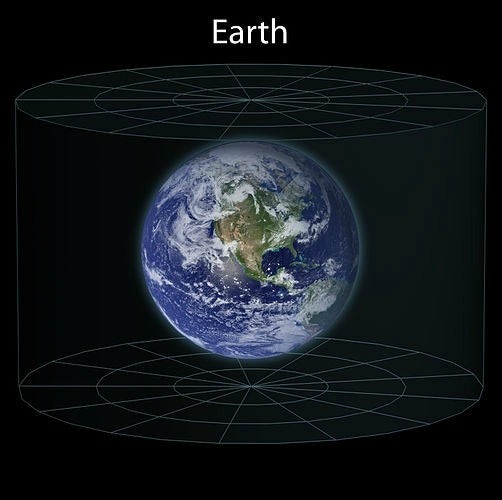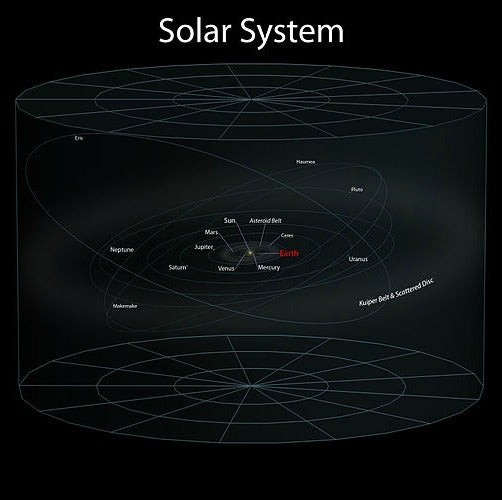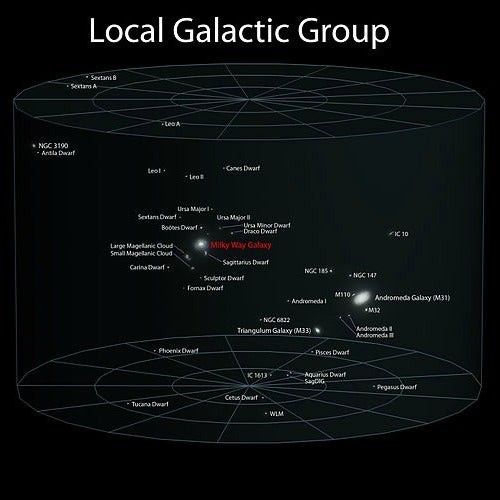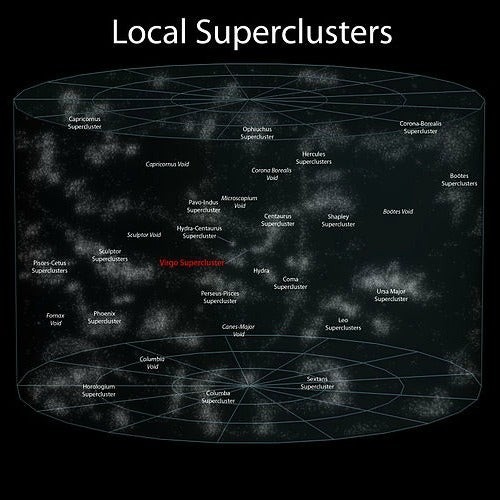How Big Is Earth Compared To The Universe? COMPARE.EDU.VN provides a comprehensive comparison to help you understand Earth’s place in the cosmos. Explore the immense scale of the universe, from our solar system to superclusters, and discover how our home planet fits into this grand cosmic picture, making informed decisions easier than ever with insights into spatial dimensions and astronomical comparisons.
1. The Earth: Our Terrestrial Home
The Earth, our home planet, is a significant object on a human scale, fostering life and civilization since the dawn of humanity. It’s the third planet from the sun and the densest in the solar system. Earth isn’t just a rock in space; it’s a dynamic system with a rich history.
-
Size and Dimensions: With a radius of 6,378 km at the equator, Earth appears vast to us. Light, traveling at an incredible speed, can circle our planet about 7.5 times in a single second.
-
Gravitational Influence: The Moon orbits Earth at an average distance of 385,000 km, about 60 times Earth’s radius. It takes light approximately 1.3 seconds to travel between Earth and the Moon.
-
Population: Our planet is currently home to around 8 billion people. Estimates suggest that roughly 106 billion people have lived on Earth throughout its history.
-
Composition: At the Earth’s core lies a solid iron ball about 1,500 miles wide, playing a vital role in generating our planet’s magnetic field.
1.1 Earth’s Vital Statistics
Understanding Earth’s vital statistics gives us a baseline for comparing it to larger cosmic structures. These stats include its mass, volume, and surface area.
- Mass: 5.97 × 10^24 kg
- Volume: 1.08 × 10^12 km³
- Surface Area: 510.1 million km²
1.2 The Significance of Earth in the Solar System
As the densest planet in the solar system, Earth’s composition and position are unique. It’s the only known planet to support life, thanks to its atmosphere, magnetic field, and distance from the sun.
2. The Solar System: Our Planetary Neighborhood
When compared to the solar system, Earth starts to look relatively small. The solar system comprises the Sun, planets, asteroids, comets, and various other celestial bodies.
-
Mass: Earth’s mass constitutes only about 0.0003% of the total mass of our solar system. The sun contains the vast majority of the mass. Earth accounts for about 0.2% of the total mass of all the planets combined.
-
Orbit: We orbit the sun at an average distance of 93 million miles, also known as 1 Astronomical Unit (AU). It takes light a little over 8 minutes to travel from the sun to Earth.
-
Planetary Distances: Neptune, the farthest planet from the sun, orbits at an average distance of 30 AU. The Voyager spacecraft is currently about 119 AU from the Sun. The dwarf planet Sedna, one of the farthest known objects, orbits at an average of 526 AU.
-
Size: The solar system has an estimated radius of about two light-years, emphasizing its vastness.
2.1 Earth’s Place Among the Planets
Compared to other planets in our solar system, Earth is the fifth largest. However, it’s the largest of the terrestrial planets (Mercury, Venus, Earth, and Mars).
| Planet | Diameter (Earths) |
|---|---|
| Mercury | 0.38 |
| Venus | 0.95 |
| Earth | 1.00 |
| Mars | 0.53 |
| Jupiter | 11.2 |
| Saturn | 9.45 |
| Uranus | 4.01 |
| Neptune | 3.88 |




2.2 The Outer Reaches of Our Solar System
Beyond the planets, the solar system extends into the Kuiper Belt and the Oort Cloud, regions populated by icy bodies and comets. These areas mark the gravitational boundary of our solar system.
3. Our Local Neighborhood: Stepping Beyond the Solar System
Moving beyond our solar system, our local neighborhood consists of nearby stars and star systems.
-
Proxima Centauri: The closest star to us is Proxima Centauri, located about four light-years away.
-
Local Interstellar Cloud: Our solar system resides within the Local Interstellar Cloud, which contains roughly 53 star systems.
-
Planets in the Neighborhood: Excluding our own solar system, there are at least six known planets in our local neighborhood, with two more suspected.
-
Size: Our local cloud spans approximately 30 light-years across.
4. The Milky Way: Our Galactic Home
The Milky Way galaxy, our galactic home, dwarfs our local neighborhood in size and complexity.
-
Location: Our solar system orbits the galactic center at an average distance of 28,000 light-years.
-
Orbital Period: One complete orbit around the galactic center, known as a galactic year, takes about 250 million years. Since life began on Earth, we’ve completed roughly 15 orbits.
-
Size: The Milky Way is about 100,000 light-years across and hosts approximately 400 billion stars. The bulge at the center is roughly 12,000 light-years in diameter.
-
Habitable Zones: Data from the Kepler Space Telescope suggests that there could be as many as 40 billion Earth-sized planets orbiting in the habitable zones of sun-like and red dwarf stars within our galaxy.
-
Dark Matter: The Milky Way has a halo of dark matter, making up over 90% of its total mass.
4.1 Comparing the Milky Way to Other Galaxies
While the Milky Way is massive, it is not the largest galaxy in the universe. IC 1101, for example, contains over 100 trillion stars, far surpassing the Milky Way’s estimated 300 billion stars.
| Galaxy | Estimated Stars |
|---|---|
| Milky Way | 300 billion |
| Andromeda | 1 trillion |
| IC 1101 | 100 trillion |
4.2 The Structure of the Milky Way
The Milky Way is a barred spiral galaxy with a central bulge, spiral arms, and a halo. Our solar system is located in one of the spiral arms, about two-thirds of the way out from the center.
5. The Local Group: Our Galaxy Cluster
The Local Group is a cluster of galaxies that includes the Milky Way and at least 47 other galaxies.
-
Members: The Andromeda galaxy is the largest member of the Local Group, followed by the Milky Way.
-
Size: The Local Group spans approximately 10 million light-years across.
-
Satellite Galaxies: The two closest galaxies to the Milky Way are the Magellanic Clouds, orbiting at a distance of less than 200,000 light-years.
-
Undiscovered Galaxies: There may be other galaxies within the Local Group that remain undetected due to their faintness or location behind other objects.
5.1 The Dynamics of Galaxy Clusters
Galaxies within a cluster are bound together by their mutual gravitational forces. They orbit around their common center of mass, leading to galaxy collisions and interactions. The Milky Way is on a collision course with the Andromeda galaxy.
5.2 The Significance of the Local Group
The Local Group provides a valuable environment for studying galaxy evolution and interactions. Understanding the dynamics of our local cluster helps astronomers piece together the history of the universe.
6. The Supercluster: Our Galactic Neighborhood Extended
Superclusters are vast collections of galaxy clusters, representing some of the largest known structures in the universe.
-
Virgo Supercluster: Our Local Group is part of the Virgo Supercluster, which spans 110 million light-years and contains about 100 galaxy clusters.
-
Individual Galaxies: The Virgo Supercluster contains roughly 2,000 individual galaxies.
-
Pisces-Cetus Supercluster Complex: Beyond the Virgo Supercluster lies the Pisces-Cetus Supercluster Complex, comprising about 60 superclusters of galaxies.
-
Size: This complex spans approximately 1.37 billion light-years, about one-tenth of the observable universe.
6.1 Understanding Supercluster Formation
Superclusters form through the gravitational attraction of smaller galaxy clusters and individual galaxies over billions of years. They represent the large-scale structure of the universe.
6.2 The Scale of Superclusters
The sheer size of superclusters is difficult to comprehend. Each supercluster contains thousands of galaxies, each with billions of stars, emphasizing the insignificance of our planet on this scale.
7. The Observable Universe: The Cosmic Horizon
The observable universe is the portion of the universe that we can see from Earth, limited by the distance that light has had time to travel since the Big Bang.
-
Size: The observable universe spans approximately 93 billion light-years in diameter, expanding continuously.
-
Superclusters: It contains an estimated 10 million superclusters, like the Virgo Supercluster.
-
Galaxies: It houses about 350 billion large galaxies, similar to the Milky Way.
-
Stars: The observable universe contains approximately 30 sextillion (30 billion trillion) stars.
7.1 The Limits of Observation
The observable universe is limited by the distance light has traveled since the Big Bang and the expansion of the universe. Beyond this horizon, there may be more universe that we cannot observe.
7.2 The Contents of the Observable Universe
The observable universe contains everything from galaxies and quasars to dark matter and dark energy. Understanding its composition helps us understand the universe’s origins and evolution.
8. Putting it in Perspective: Earth’s Relative Size
Let’s put these cosmic scales into perspective with some quick math:
- Earth vs. Human: Earth is about 3.5 million times larger than a human.
- Solar System vs. Earth: The solar system is about 36 billion times larger than Earth (3.6 x 10^10).
- Local Group vs. Solar System: The Local Group is 5 million times larger than the solar system (1.4 x 10^17 times larger than Earth).
- Virgo Supercluster vs. Local Group: The Virgo Supercluster is 11 times larger than the Local Group (1.5 x 10^18 times larger than Earth).
- Pisces-Cetus Supercluster Complex vs. Virgo Supercluster: The Pisces-Cetus Supercluster Complex is 12 times larger than the Virgo Supercluster (1.9 x 10^21 times larger than Earth).
- Observable Universe vs. Pisces-Cetus Supercluster Complex: The observable universe is 10 times larger than the Pisces-Cetus Supercluster Complex (1.9 x 10^22 times larger than Earth).
| Celestial Object | Relative Size (Compared to Earth) |
|---|---|
| Human | 1 / 3,500,000 |
| Solar System | 3.6 x 10^10 |
| Local Group | 1.4 x 10^17 |
| Virgo Supercluster | 1.5 x 10^18 |
| Pisces-Cetus Supercluster Complex | 1.9 x 10^21 |
| Observable Universe | 1.9 x 10^22 |
9. Visualizing the Scale of the Universe
To better understand these enormous scales, consider these analogies:
- If Earth were the size of a marble, the sun would be the size of a beach ball located about 25 meters away.
- On this scale, the nearest star, Proxima Centauri, would be another beach ball located over 7,000 kilometers away.
- The Milky Way galaxy would be a collection of beach balls spanning millions of kilometers.
10. The Implications of Earth’s Size Relative to the Universe
Understanding Earth’s size relative to the universe has profound implications for our perspective on life, our place in the cosmos, and the possibilities of finding life beyond Earth.
10.1 Philosophical Implications
Our small size in the vast universe can lead to feelings of insignificance or, conversely, a sense of wonder and appreciation for the uniqueness of our planet.
10.2 Scientific Implications
Studying the universe helps us understand its origins, evolution, and the fundamental laws of physics that govern it. This knowledge can lead to technological advancements and a deeper understanding of our place in the cosmos.
11. Earth’s Unique Characteristics
Despite its relatively small size, Earth possesses unique characteristics that make it habitable.
11.1 Atmosphere and Climate
Earth’s atmosphere protects us from harmful solar radiation and maintains a temperature range suitable for liquid water, essential for life.
11.2 Geological Activity
Plate tectonics, volcanic activity, and the Earth’s magnetic field contribute to a dynamic environment that supports life.
11.3 Presence of Water
Liquid water covers over 70% of Earth’s surface, providing a medium for life and playing a crucial role in climate regulation.
12. The Search for Life Beyond Earth
The vastness of the universe suggests that life might exist elsewhere. Scientists are actively searching for exoplanets, planets orbiting other stars, that could potentially harbor life.
12.1 Exoplanet Discoveries
Thousands of exoplanets have been discovered in recent years, some of which are Earth-sized and located in the habitable zones of their stars.
12.2 The Drake Equation
The Drake Equation is a probabilistic argument used to estimate the number of active, communicative extraterrestrial civilizations in the Milky Way galaxy.
13. Future Perspectives on Cosmic Size Comparisons
As our technology advances, we will be able to explore more of the universe and refine our understanding of its scale. Future telescopes and space missions will provide more detailed observations and insights into the cosmos.
13.1 Advancements in Telescope Technology
Next-generation telescopes, such as the James Webb Space Telescope, will allow us to see farther into the universe and study exoplanets in greater detail.
13.2 Interstellar Travel
While currently beyond our capabilities, interstellar travel could one day allow us to explore nearby star systems and search for life beyond Earth.
14. Engaging with the Cosmos
Learning about the universe can be an enriching experience. There are many ways to engage with astronomy and space exploration.
14.1 Visiting Planetariums and Observatories
Planetariums and observatories offer educational programs and opportunities to view the night sky through telescopes.
14.2 Online Resources and Communities
Numerous websites, forums, and social media groups are dedicated to astronomy and space exploration, providing a wealth of information and opportunities to connect with fellow enthusiasts.
15. Addressing Common Misconceptions
There are several common misconceptions about the size and scale of the universe. Addressing these can help clarify our understanding.
15.1 The Universe is Static
The universe is not static; it is expanding. Galaxies are moving away from each other, and the rate of expansion is accelerating.
15.2 The Big Bang was an Explosion in Space
The Big Bang was not an explosion in space but rather an expansion of space itself. It occurred everywhere at once, not at a specific point in space.
16. Understanding Light Years
A light-year is the distance that light travels in one year, approximately 9.461 × 10^12 kilometers (5.879 × 10^12 miles). This unit is essential for measuring vast distances in the universe.
16.1 Calculating Distances in Light Years
To calculate the distance in light-years, you need to know the speed of light (approximately 299,792 kilometers per second) and the time it takes for light to travel from one point to another.
16.2 Practical Examples of Light Year Distances
- The nearest star, Proxima Centauri, is about 4.246 light-years away.
- The center of our Milky Way galaxy is about 26,000 light-years away.
- The Andromeda galaxy is about 2.537 million light-years away.
17. The Concept of Infinity in the Universe
The question of whether the universe is infinite or finite is one of the biggest unsolved problems in cosmology.
17.1 Arguments for a Finite Universe
Some theories suggest that the universe is finite but unbounded, meaning that it has a limited volume but no edge.
17.2 Arguments for an Infinite Universe
Other theories propose that the universe is infinite, extending endlessly in all directions.
18. Dark Matter and Dark Energy’s Role
Dark matter and dark energy make up the vast majority of the universe, yet they are invisible and poorly understood.
18.1 What is Dark Matter?
Dark matter is a mysterious substance that does not interact with light or other electromagnetic radiation. Its presence is inferred from its gravitational effects on visible matter.
18.2 What is Dark Energy?
Dark energy is an even more mysterious force that is causing the expansion of the universe to accelerate.
19. The Multiverse Theory
The multiverse theory suggests that our universe may be just one of many universes, each with its own physical laws and constants.
19.1 Different Types of Multiverse
There are several different types of multiverse theories, including the many-worlds interpretation of quantum mechanics, brane cosmology, and the inflationary multiverse.
19.2 Implications of the Multiverse
If the multiverse exists, it would have profound implications for our understanding of the universe and our place within it.
20. Frequently Asked Questions (FAQ)
Q1: How many Earths could fit into the Sun?
Approximately 1.3 million Earths could fit inside the Sun.
Q2: What is the farthest object humans have sent into space?
The Voyager 1 spacecraft is the farthest object humans have sent into space.
Q3: How old is the universe?
The universe is estimated to be about 13.8 billion years old.
Q4: What is the size of the observable universe?
The observable universe is about 93 billion light-years in diameter.
Q5: Are we alone in the universe?
We don’t know yet. Scientists are actively searching for life beyond Earth.
Q6: What is the closest galaxy to the Milky Way?
The Canis Major Dwarf Galaxy is the closest galaxy to the Milky Way.
Q7: How fast is the universe expanding?
The universe is expanding at a rate of about 73 kilometers per second per megaparsec.
Q8: What is a black hole?
A black hole is a region of spacetime with such strong gravity that nothing, not even light, can escape from it.
Q9: What is a quasar?
A quasar is an extremely luminous active galactic nucleus powered by a supermassive black hole.
Q10: What is the cosmic microwave background radiation?
The cosmic microwave background radiation is the afterglow of the Big Bang, a faint radiation that fills the universe.
21. Conclusion: Our Place in the Cosmic Tapestry
While Earth may seem small compared to the vastness of the universe, it is our unique and precious home. Understanding its place in the cosmos can inspire awe, curiosity, and a sense of responsibility to protect our planet.
Are you struggling to compare different options and make informed decisions? Visit COMPARE.EDU.VN for comprehensive and objective comparisons. Whether you’re weighing the pros and cons of different products, services, or ideas, our platform offers detailed analysis, expert reviews, and user feedback to help you make the best choice.
Navigate the complexities of decision-making with ease and confidence. Visit COMPARE.EDU.VN today and make smarter choices.
Contact Information:
Address: 333 Comparison Plaza, Choice City, CA 90210, United States
WhatsApp: +1 (626) 555-9090
Website: compare.edu.vn